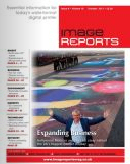This year’s Widthwise survey showed that when it came to R&D, you wanted manufacturers to place an onus on reducing the running costs of large-format printers. So are they?
One of the key findings in the technology section of Image Reports’ annual Widthwise survey was that when it came to where print companies most wanted to see printer manufacturers put their R&D spend, it was in reducing the running costs of the large-format printers they make. So of course, we asked a number of key players about where this issue currently figures in their R&D strategy and what they are doing to try and make the kit more efficient. Some where happy to outline their thoughts and actions, but from many quarters the response was a deafening silence which can only leave one to wonder about the kind of feedback potential customers get from suppliers when they ask the sam, increasingly asked, question!



